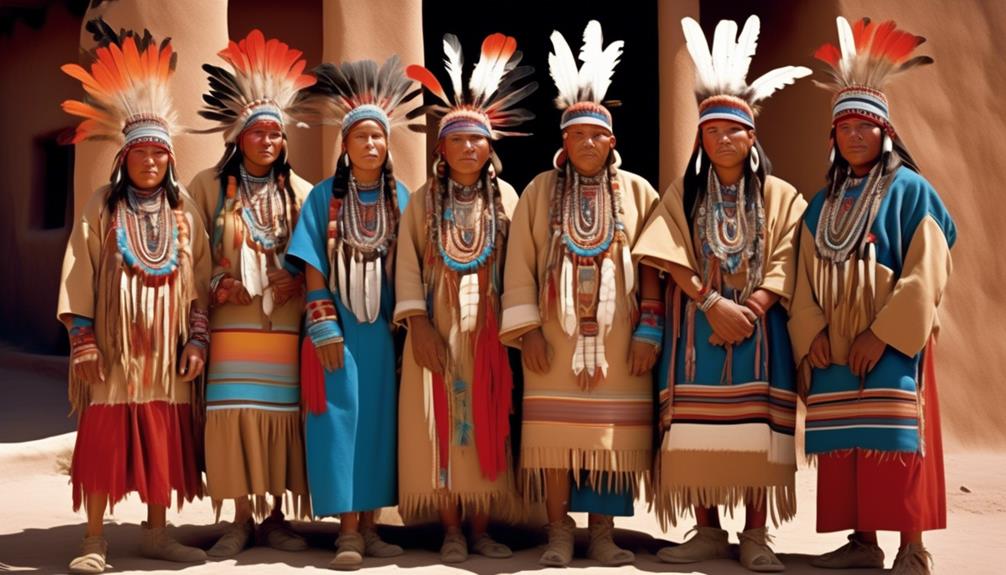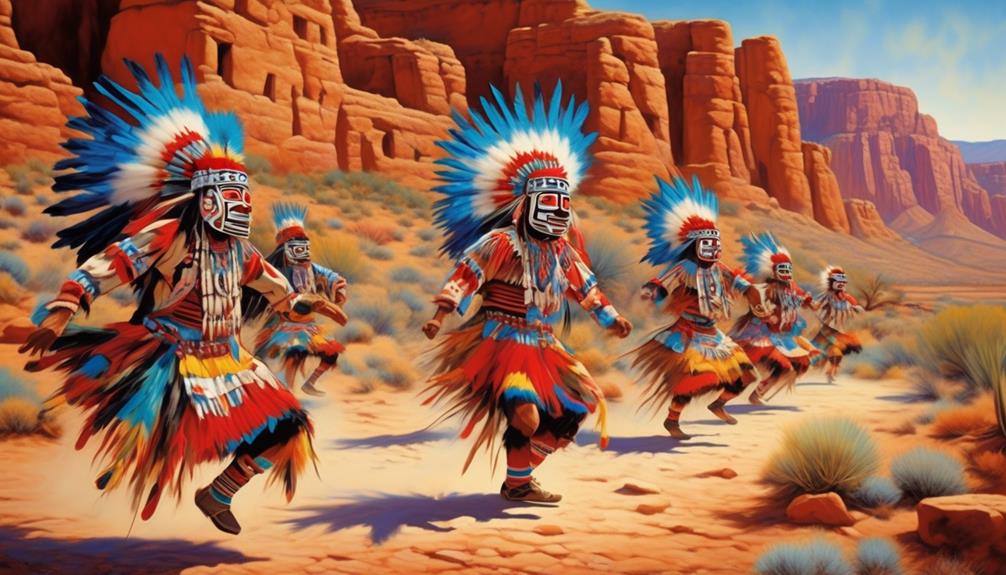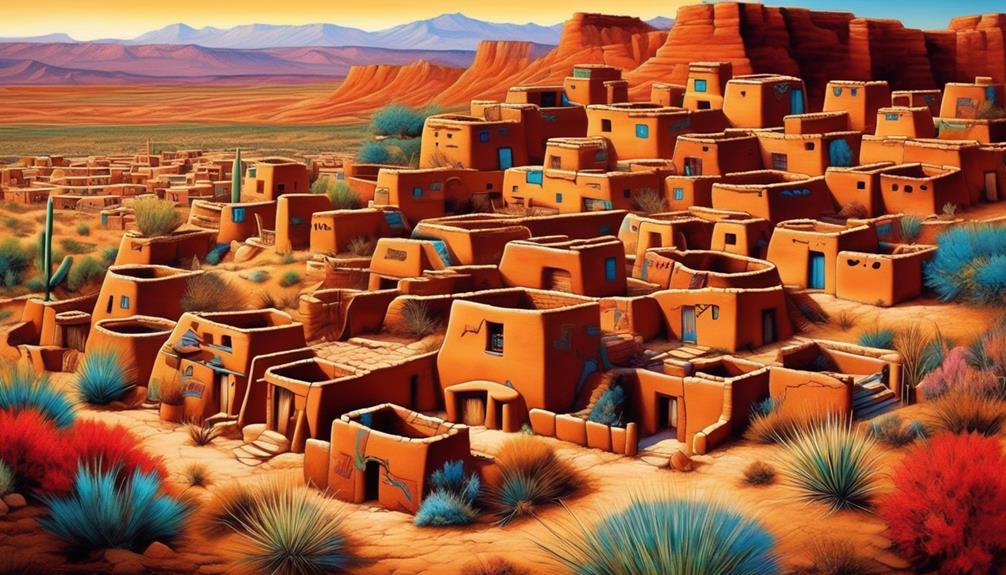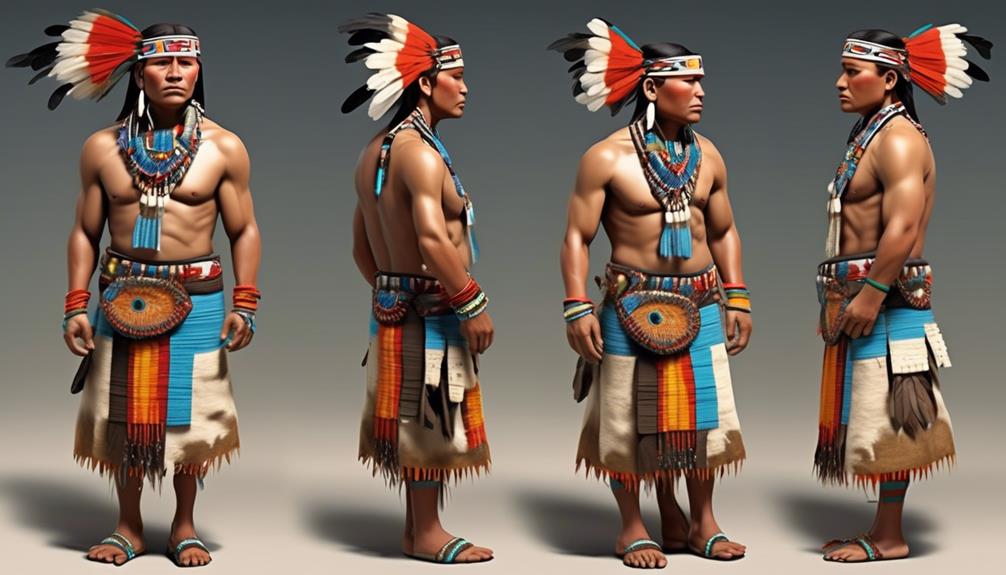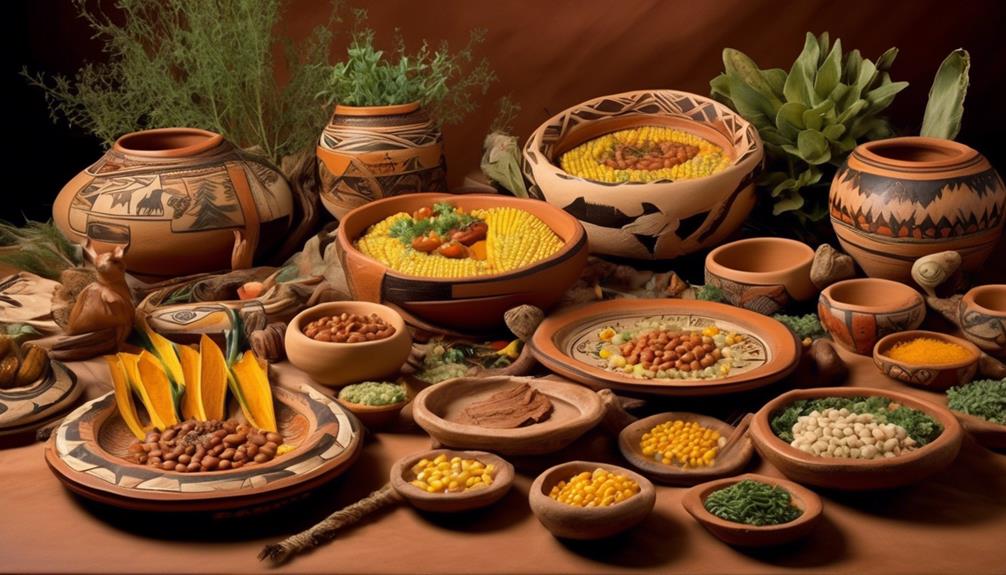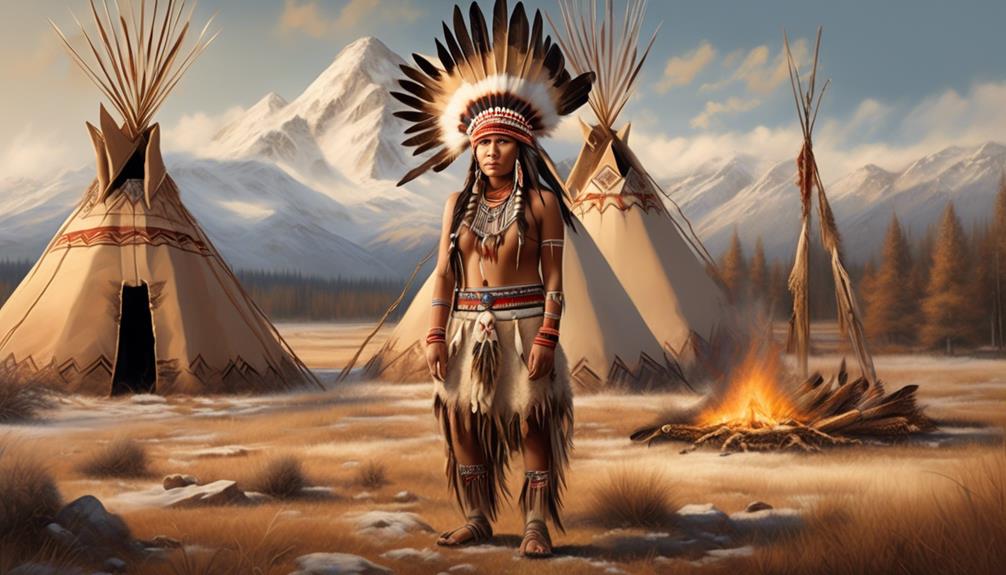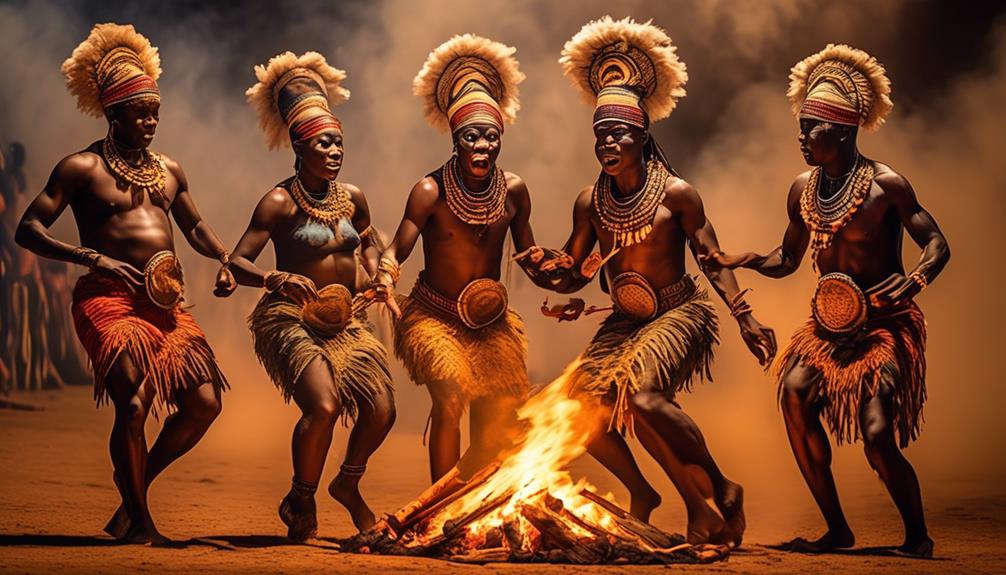Have you ever thought you knew what the Hopi tribe looked like? Think again.
The physical appearance of the Hopi people is a fascinating subject that goes beyond just outward appearances. From their traditional clothing and adornments to their hairstyles and grooming practices, the Hopi tribe has a rich and symbolic history woven into their attire.
But what did all of this actually look like? Stay tuned to uncover the layers of symbolism and meaning in Hopi attire that offer a deeper insight into the tribe's culture and evolution of fashion.
Key Takeaways
- The physical characteristics of the Hopi tribe include a resilient stature developed over generations in the arid desert landscape, as well as strikingly beautiful and expressive facial features that reflect wisdom and fortitude.
- Traditional Hopi clothing and adornments hold cultural significance and represent history, spirituality, and artistic heritage. Ceremonial attire represents spiritual beings and ancestors, while decorative accessories symbolize connection to the earth and sky.
- Hairstyles and grooming practices vary based on age, gender, and ceremonial roles within the Hopi tribe. Unmarried Hopi maidens wear elaborate butterfly whorls, while married women style their hair more modestly. Men typically keep their hair at medium length or closely cropped for agricultural activities.
- Symbolism and meaning are important aspects of Hopi attire. Colors hold significant meaning, intricate designs depict cultural symbols, geometric patterns symbolize harmony and balance, and images of animals and plants hold spiritual significance. Hopi attire serves to preserve cultural heritage and represent the collective identity and connection to the land.
Physical Characteristics of the Hopi People
The physical characteristics of the Hopi people are a reflection of their unique and enduring cultural heritage. Their physical features hold deep cultural significance, often serving as a visual representation of their connection to the land and their traditional way of life.
One distinctive physical feature of the Hopi is their strong, resilient stature, developed over generations of living in the arid desert landscape of the American Southwest. This physical strength isn't only a result of genetic adaptation but also a testament to the resilience and perseverance ingrained in their culture.
Additionally, the Hopi people are known for their strikingly beautiful and expressive facial features. These features often reflect a sense of wisdom, pride, and fortitude, mirroring the values deeply embedded in their cultural traditions. The cultural significance of these physical attributes is evident in the way they're revered and celebrated within the Hopi community.
Moreover, the traditional attire of the Hopi people, adorned with vibrant colors and intricate designs, further showcases the cultural significance of their physical appearance. The attire isn't merely ornamental; it's a living embodiment of their history, spirituality, and artistic expression.
The physical characteristics of the Hopi people are a testament to the rich tapestry of their cultural heritage, representing resilience, wisdom, and a profound connection to their land and traditions.
Traditional Clothing and Adornments
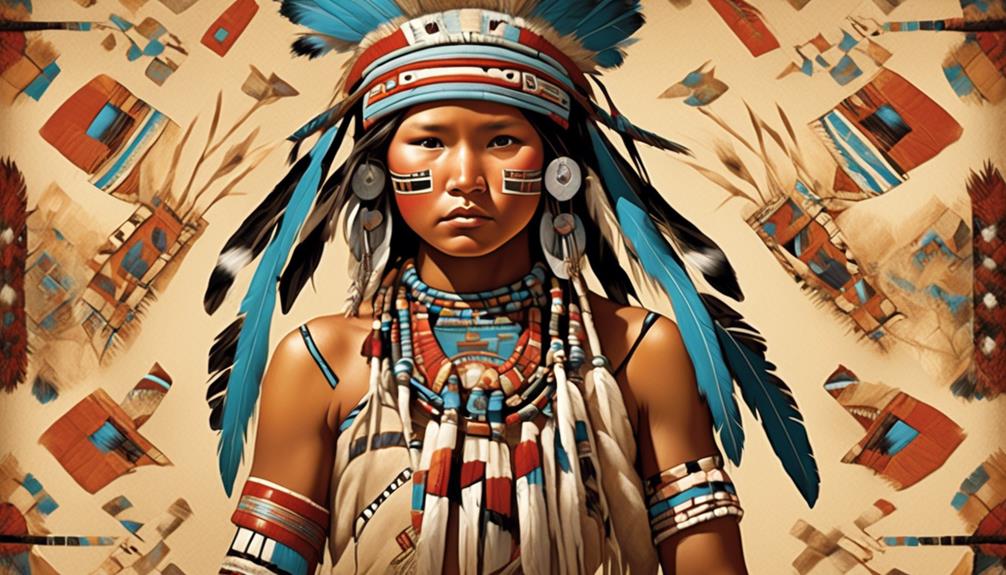
Reflecting the cultural significance of their physical appearance, the Hopi people's traditional clothing and adornments serve as vibrant expressions of their history, spirituality, and artistic heritage. The ceremonial attire and decorative accessories worn by the Hopi tribe are integral to their cultural identity and play a significant role in their religious and social practices.
| Ceremonial Attire | Decorative Accessories | Significance |
|---|---|---|
| Kachina Dance attire | Silver jewelry | Represents spiritual beings and ancestors |
| Pueblo-style clothing | Turquoise and coral | Symbolizes connection to the earth and sky |
| Elaborate headdresses | Shell and beadwork | Reflects intricate craftsmanship and tradition |
| Body paint and tattoos | Feathered fans | Embodies spiritual and ceremonial significance |
The ceremonial attire, which often includes vibrant colors and intricate patterns, is worn during religious ceremonies and dances, symbolizing the tribe's deep spiritual connections. Additionally, decorative accessories such as silver jewelry, turquoise, and coral are not only aesthetically pleasing but also hold profound symbolic meaning, representing the Hopi people's connection to their ancestors, the natural world, and their artistic heritage. The elaborate headdresses, shell and beadwork, body paint, tattoos, and feathered fans further showcase the intricate craftsmanship and spiritual significance woven into the fabric of Hopi traditional clothing and adornments.
Hairstyles and Grooming Practices
In understanding the Hopi tribe's cultural practices, it's insightful to delve into their diverse hairstyles and grooming customs, which bear historical and symbolic significance.
Traditional hairstyles among the Hopi people varied based on age, gender, and ceremonial roles. For example, unmarried Hopi maidens often wore their hair in elaborate butterfly whorls, symbolizing the transformation and beauty of nature. Married women, on the other hand, typically styled their hair in a more modest and practical manner, often covering it with a traditional shawl. Men often kept their hair at a medium length, with some opting for a more closely cropped style for practicality during their agricultural activities.
Grooming rituals were significant within the Hopi tribe, with cleanliness being highly valued. The use of natural materials such as yucca suds for washing and juniper ash for hair cleaning was common. These grooming practices weren't only for hygiene but also held spiritual and ceremonial significance within the tribe, reflecting a deep connection to the natural world and the spirits they revered.
Symbolism and Meaning in Hopi Attire
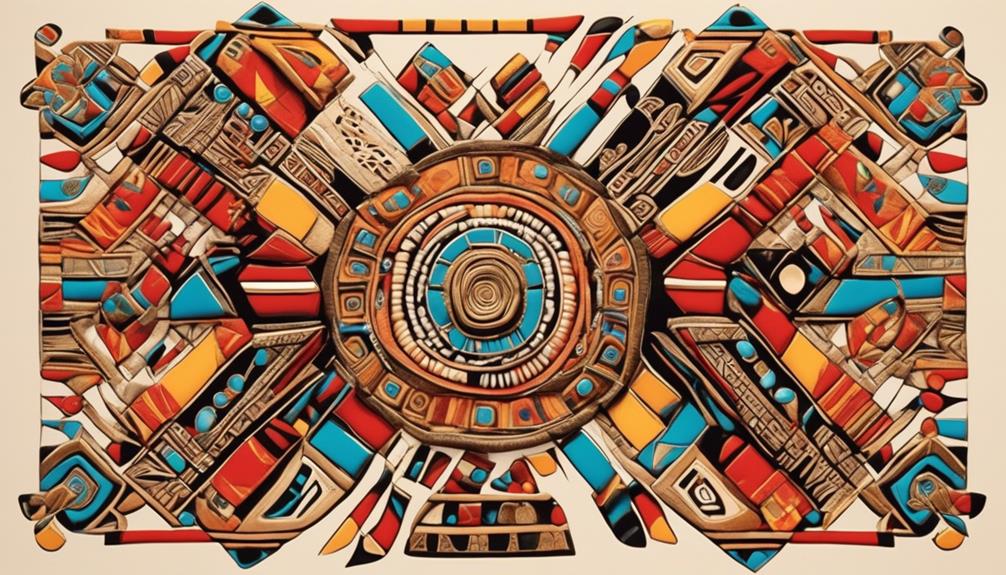
Adorned in vibrant colors and intricate designs, Hopi attire conveys deep cultural significance and spiritual symbolism. The traditional clothing of the Hopi people is rich in symbolism, reflecting their connection to the natural world and their spiritual beliefs.
- Color Symbolism: The colors used in Hopi attire hold significant meaning. For example, the color blue represents the sky and water, symbolizing life and fertility. Yellow symbolizes the sun and growth, while red is associated with the earth and the life force. These colors are carefully chosen to convey specific messages and honor the natural elements that sustain their way of life.
- Design Symbolism: The intricate designs found in Hopi attire often depict symbols that represent important aspects of their culture and beliefs. Geometric patterns may symbolize harmony and balance, while images of animals and plants hold spiritual significance, connecting the wearer to the natural world and ancestral traditions.
- Cultural Significance: Beyond their aesthetic appeal, Hopi attire plays a crucial role in preserving and celebrating the tribe's cultural heritage. Each garment and accessory is a testament to their enduring traditions and serves as a visual representation of their collective identity and spiritual connection to the land.
Adaptation and Evolution of Hopi Fashion
Hopi fashion has undergone a dynamic evolution, adapting to changing influences while retaining its cultural significance and spiritual essence.
Traditional Hopi clothing, once made from woven cotton, has now incorporated modern materials such as wool, silk, and synthetic fibers due to cultural influences and availability. The shift from solely utilitarian attire to more elaborate ceremonial dress reflects the impact of cultural exchange and the preservation of traditional values. The incorporation of vibrant dyes and intricate patterns also showcases the adaptation of Hopi fashion to contemporary aesthetics while maintaining its historical roots.
The evolution of Hopi fashion is evident in the integration of jewelry and accessories. While traditional adornments were often made from natural materials like shells, feathers, and animal bones, contemporary Hopi jewelry incorporates metals such as silver and gold, reflecting the influence of external cultures and the adaptation of traditional designs to a wider market. The symbolic significance of these accessories remains deeply ingrained in Hopi culture, emphasizing the seamless blend of tradition and adaptation in their fashion.
Frequently Asked Questions
What Are Some Common Misconceptions About the Physical Appearance of the Hopi People?
Common misconceptions about the physical appearance of the Hopi people often stem from a lack of understanding of their traditional clothing variation, ritual hairstyles, and symbolic motifs.
These misconceptions overlook the modern influence on the tribe's appearance.
The Hopi's physical appearance is diverse and dynamic, reflecting their rich cultural heritage.
It's essential to recognize the complexity and nuance of their appearance, which has evolved over time and continues to be influenced by contemporary factors.
How Do Traditional Clothing and Adornments Vary Between Different Hopi Clans or Groups?
When exploring traditional clothing and adornments among different Hopi clans, the rich tapestry of symbolism and heritage emerges. Clan variations in attire reflect distinct nuances in cultural expression, from color palettes to intricate patterns.
Adornment symbolism is woven into every fabric, evoking a profound sense of identity and tradition. Each clan's unique attire serves as a living testament to the enduring legacy of the Hopi people, embodying resilience and pride.
Are There Any Specific Hairstyles or Grooming Practices That Are Unique to Certain Hopi Ceremonies or Rituals?
Hairstyle variations within the Hopi tribe are tied to specific ceremonies and rituals, reflecting cultural significance.
Grooming traditions play a crucial role in these practices, with hairstyles often influenced by spiritual beliefs and community customs.
Different ceremonies may have specific guidelines for hair and grooming.
These practices not only impact attire but are also a means of preserving and honoring the tribe's heritage.
Can You Explain the Significance of Specific Symbols or Motifs Found in Hopi Attire?
Exploring symbols and motifs in Hopi attire reveals a rich cultural significance. Traditional clothing variations showcase intricate designs reflecting spiritual beliefs.
Grooming practices are integral, symbolizing connection to the natural world.
Modern fashion influence highlights the enduring legacy of Hopi artistic expression.
The vibrant colors, geometric patterns, and sacred motifs in Hopi attire are a testament to the tribe's enduring cultural traditions.
How Has Modern Fashion and Clothing Influenced the Traditional Attire of the Hopi People?
Fashion influence has impacted the traditional attire of the Hopi people, leading to modern adaptations while also emphasizing cultural preservation.
The integration of modern materials and styles reflects our evolving society while maintaining the essence of our heritage. This fusion allows for the continuation of our traditions, showcasing the resilience of our culture in the face of contemporary influences.
The traditional attire of the Hopi tribe remains a symbol of our identity, evolving alongside modern fashion.
Conclusion
In conclusion, the Hopi people were known for their distinctive physical features, traditional clothing, and intricate adornments. Their hairstyles and grooming practices reflected their cultural identity and beliefs, while their attire held deep symbolic meaning.
Over time, Hopi fashion has evolved and adapted to modern influences, yet still maintains its unique and timeless appeal like a well-worn story passed down through generations.
Mary is a passionate writer who brings creativity and a fresh perspective to our team. Her words have the power to captivate and inspire, making her an essential contributor to our content. Mary’s commitment to storytelling and dedication to promoting Indigenous culture ensures that her work touches the hearts of our readers. We’re fortunate to have her as part of our team.
